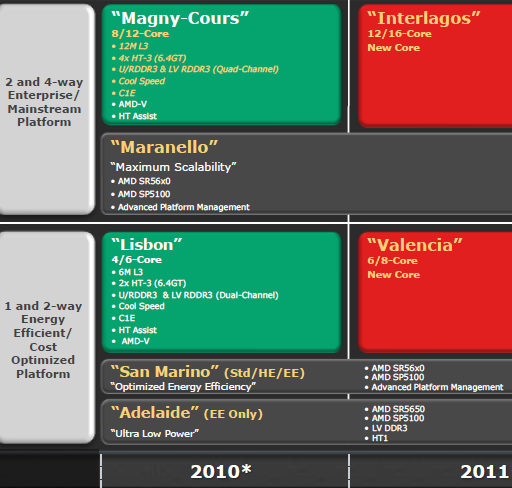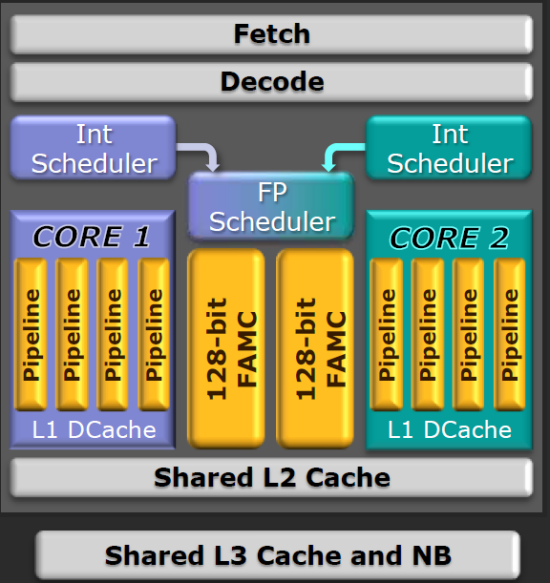AMD's 2010/2011 Roadmap from the IT Professional’s Perspective
by Johan De Gelas on November 23, 2009 12:00 AM EST- Posted in
- IT Computing
Expensive 2-Socket Servers
When it comes to expensive 2-socket servers, AMD positioning is cunning. In the midrange we will find servers with sixteen Opteron cores (2-socket x 2-quad-core die per socket) offering 8 memory channels and 24 DIMM slots. Performance will probably be “close enough” to the Westmere EP servers , which can only offer six memory channels and 18 DIMM slots. The extra amount of memory bandwidth might make a dual Opteron 6100 attractive to the HPC folks, while the higher amounts of DIMM slots together with a competitive price may very well convince the virtualization market.
Midrange and Budget 2-Socket Servers

Ultra Low Power Server
AMD had some succes in the ultra low power market and clearly wants more. The “Adelaide” platform is the successor the power optimized “Kroner” platform. Low power memory and chipset, voltage regulators and PSUs that only support low power Opterons: every component is tuned for low power. Remarkably, the ACP of the Opteron 4100 EE is lowered to a very low 35W ACP, or less than 6W per CPU. AMD feels these CPUs offer an excellent alternative to the VIA Nano and Intel Atom based servers. Instead of running one small website on an Intel Atom based server, AMD hopes that ISPs will prefer to run 6 websites on a container based solution. So each website would get it’s own 6 Watt core which is much more powerful than the best Intel Atom CPUs.
Upgrade to Bulldozer

We will discuss this core in more detail but here are some extra tidbits we managed to find out:
• Two integer clusters share fetch and decode logic but have their own dedicated Instruction and Data cache
• Integer clusters can not be shared between threads: integer cores act like a Chip Multi Processing (CMP) CPU.
• The extra integer core (schedulers, D-cache and pipelines) adds only 5% die space
• L1-caches are similar to Barcelona/Shanghai (64 KB 2-way? Not confirmed)
• Up to 4 modules share a L3-cache and Northbridge
• Two times 4 Bulldozer modules (2 x 8 "cores" or 16 cores) are about 60 to 80% faster than the twelve core Opteron 6100 CPU in SPECInt_rate.
With Bulldozer, AMD finally seems to have designed an aggressive integer core. Since the introduction of the Intel Woodcrest in 2006, Intel’s CPUs have been offering superior integer crunching performance per core. Since integer performance determines the performance of 90-95% of the server application out there, this is a big deal.
Conclusion
Intel has a very strong product lineup for each segment of the market: the massive octalcore Nehalem EX for the “mission-critical” high-end, the six-core Westmere-EP for the midrange and the “Lynfield” based Xeons for the low power market. But AMD doesn't roll over willingly: it breaks all market segment rules and shatters some (artificial?) boundaries. That will result in some very interesting opportunities for the server buyers in 2010.
So which products are worth watching or waiting for? The G34 Opteron 6100 will find a home in 48-core servers, and these servers should be a cheaper alternative to the 32-core Nehalem EX servers in the high-end. We are not completely convinced that performance and RAS features will be compelling enough to sway the typical Nehalem EX buyers (OLTP, ERP) towards an AMD Opteron server. That is our first impression, but we will give AMD the benefit of the doubt of course.
We are much more enthusiastic about AMD’s highend 2-socket platform. The fact that you will be able to buy a relatively cheap (compared to 4-socket solutions) 2-socket server with two quad channel octal cores is very attractive and a great strategic move by AMD. A platform with 16 cores (or 24 if you like) and 24 DIMM slots might attract quite a lot of typical 2-socket “virtualization consolidation” server buyers.
The other really compelling offer to the market might be the Adelaide platform, depending on how high the premium is that AMD wants for its EE Opterons. AMD has been asking pretty high prices for it’s lowest power Opterons, clearly targetting the "Facebooks" and "Googles" of the world. But if AMD is going after the Intel Atom server market, it may mean that it's going to offer some low power products in price ranges that are interesting to the rest of us.










107 Comments
View All Comments
BaronMatrix - Tuesday, November 24, 2009 - link
I mean every other sentence was, but Intel has this, Intel has that. Are you trying to be Fox News?Chlorus - Tuesday, November 24, 2009 - link
How could mentioning their competition possibly be relevant? I know, right?jeffrey - Tuesday, November 24, 2009 - link
Any updates on Tukwila?Last I heard was Q1 of 2010 for OEM shipment.
Since this article mentioned Top500, maybe a conversation or Blog post on the status of that processor platform as a whole?
HurleyBird - Tuesday, November 24, 2009 - link
• 4 Bulldozer modules are about 60 to 80% faster than one six-core Opteron 6100 CPU in SPECInt_rate.The 6100 is a 12-core product, no? So either "six-core" or "Opteron 6100" is a typo. If it's 60-80% faster than the 12-core product, then that's a pretty huge increase.
JohanAnandtech - Tuesday, November 24, 2009 - link
Thanks for the feedback. I adapted the text and made it more clear: one 2x 8 core Interlagos is 60 to 80% faster than a 2x6 core Magny cours.Adsski - Tuesday, November 24, 2009 - link
Given a 60 - 80% increase whilst going from 12 to 16 cores, would it be reasonable to state that this is a 20 - 35% improvement per core.MDme - Tuesday, November 24, 2009 - link
It begs the question though,Is this 8 core or module interlagos CPU? because an 8 "core" interlagos cpu might be a 4 module (ergo 8 integer core) cpu or is this an 8 core (as in module) with 16 integer cores.
If it is a 4 module (8 integer core) cpu then the improvement will be as much as 40-70% per module.
If it is an 8 module (16 integer core) cpu then it will be as stated by a few a 20-35% improvement per module
This is confusing since AMD and the article did not clarify their statement whether they are talking interlagos as a 16-core in the traditional sense or were they referring to it as a 16 core ( 8 module) CPU - an octal core with 16 integer "cores")
JFAMD - Tuesday, November 24, 2009 - link
Perhaps we have not been clear, so let me clarify.There is a bulldozer module, NOT a bulldozer core.
Each bulldozer module has 2 integer cores in it.
A 16-core interlagos will consist of 8 modules and 16 total integer cores.
Just for the record, the hardware will see 16 cores, not 8 modules. The operating system will see 16 cores, not 8 modules. The application will see 16 cores, not 8 modules. There are only 2 places that people will see the modules: in the architectural layout and on my powerpoint slides. Beyond those two places, it is all cores.
MDme - Wednesday, November 25, 2009 - link
I see. Thanks for the clarification. With this info however, do you think AMD can achieve it's goal of having the "fastest" uarch out there when they do release? Isn't that what they claimed for Bulldozer? Since this is 2011, Intel will have further improvements down the line too.JohanAnandtech - Tuesday, November 24, 2009 - link
That is reasonable. It is hard to tell as Bulldozer will scale quite a bit better too. But it is clear that AMD has - finally - made some serious progress in integer single threaded performance too.